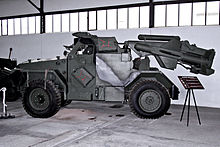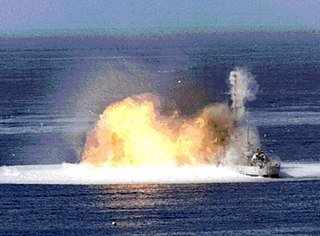
A thermobaric weapon, also called an aerosol bomb, or a vacuum bomb, is a type of explosive munition that works by dispersing an aerosol cloud of gas, liquid or powdered explosive. The fuel is usually a single compound, rather than a mixture of multiple molecules. Many types of thermobaric weapons can be fitted to hand-held launchers, and can also be launched from airplanes.
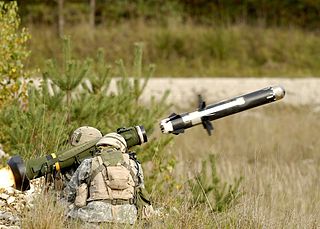
An anti-tank guided missile (ATGM), anti-tank missile, anti-tank guided weapon (ATGW) or anti-armor guided weapon is a guided missile primarily designed to hit and destroy heavily armored military vehicles. ATGMs range in size from shoulder-launched weapons, which can be transported by a single soldier, to larger tripod-mounted weapons, which require a squad or team to transport and fire, to vehicle and aircraft mounted missile systems.

The Panzerfaust was a development family of single-shot man-portable anti-tank systems developed by Nazi Germany during World War II. The weapons were the first single-use light anti-tank weapons based on a pre-loaded disposable launch tube, a weapon configuration which is still used today.

R4M, abbreviation for Rakete, 4 kilogramm, Minenkopf, also known by the nickname Orkan due to its distinctive smoke trail when fired, was a folding-fin air-to-air rocket used by the Luftwaffe at the end of World War II.
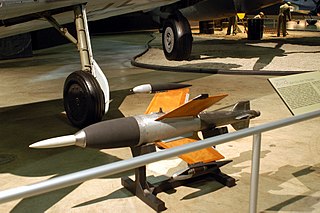
The Ruhrstahl Ru 344 X-4 or Ruhrstahl-Kramer RK 344 was a wire-guided air-to-air missile designed by Germany during World War II. The X-4 did not see operational service and thus was not proven in combat but inspired considerable post-war work around the world, and was the basis for the development of several ground-launched anti-tank missiles.

The Mk 153 Shoulder-Launched Multipurpose Assault Weapon (SMAW) is a smoothbore shoulder-fired rocket launcher. It is a portable assault weapon and has a secondary anti-armor ability. Developed from the B-300, it was introduced to the United States Armed Forces in 1984. It has a maximum effective range of 500 metres (550 yd) against a tank-sized target.
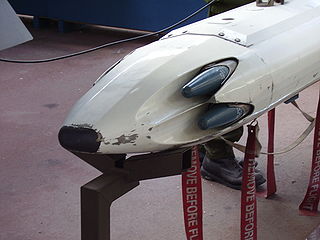
The CRV7, short for "Canadian Rocket Vehicle 7", is a 2.75-inch (70 mm) folding-fin ground attack rocket produced by Bristol Aerospace in Winnipeg, Manitoba. It was introduced in the early 1970s as an upgraded version of the standard U.S. 2.75-inch air-to-ground rockets. It was the most powerful weapon of its class, the first with enough energy to penetrate standard Warsaw Pact aircraft hangars. The CRV7 remains one of the most powerful air-to-ground attack rockets to this day, and has slowly become the de facto standard for Western-aligned forces outside the United States. Beginning in 2021, 83,303 stored Canadian CRV7s are slated for disposal having been removed from service from 2005 to 2007. In 2024 the Department of National Defence is considering donating the rockets to Ukraine as military aid to defend against the Russian invasion of Ukraine. An estimated 8,000 rockets have functioning warheads while the remainder could be used for parts or modification.

Swingfire was a British wire-guided anti-tank missile developed in the 1960s and produced from 1966 until 1993. The name refers to its ability to make a rapid turn of up to ninety degrees after firing to bring it onto the line of the sighting mechanism. This means that the launcher vehicle could be concealed and the operator, using a portable sight, placed at a distance in a more advantageous firing position.

The MGR-1 Honest John rocket was the first nuclear-capable surface-to-surface rocket in the United States arsenal. Originally designated Artillery Rocket XM31, the first unit was tested on 29 June 1951, with the first production rounds delivered in January 1953. Its designation was changed to M31 in September 1953. The first Army units received their rockets by year's end and Honest John battalions were deployed in Europe in early 1954. Alternatively, the rocket was capable of carrying an ordinary high-explosive warhead weighing 1,500 pounds (680 kg).
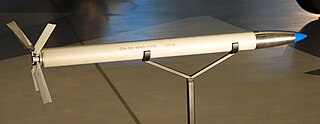
The Mk 4 Folding-Fin Aerial Rocket (FFAR), also known as "Mighty Mouse", is an unguided rocket used by United States military aircraft. It was 2.75 inches (70 mm) in diameter. Designed as an air-to-air weapon for interceptor aircraft to shoot down enemy bombers, it primarily saw service as an air-to-surface weapon. The FFAR has been developed into the modern Hydra 70 series, which is still in service.

The Hughes AIM-47 Falcon, originally GAR-9, was a very long-range high-performance air-to-air missile that shared the basic design of the earlier AIM-4 Falcon. It was developed in 1958 along with the new Hughes AN/ASG-18 radar fire-control system intended to arm the Mach 3 XF-108 Rapier interceptor aircraft and, after that jet's cancellation, the YF-12A. It was never used operationally, but was a direct predecessor of the AIM-54 Phoenix used on the Grumman F-14 Tomcat.
The Panzerfaust 3 is a modern semi-disposable recoilless anti-tank weapon, which was developed between 1978 and 1985 and first entered service with the Bundeswehr in 1987. It was first ordered in 1973 to provide West German infantry with an effective weapon against contemporary Soviet armor, thereby replacing West Germany's aging PzF 44 Light Lanze launchers and the heavy Carl Gustaf 84 mm anti-tank recoilless rifle manufactured in Sweden.

The Vickers Vigilant was a British 1960s era MCLOS wire-guided anti-tank missile used by the British Army. It was also licence-built in the United States by Clevite for the US Marine Corps, and sometimes known as Clevite rounds in this case.

The RP-3 was a British air to ground rocket projectile introduced during the Second World War. The "3 inch" designation referred to the nominal diameter of the rocket motor tube. The use of a 60 lb (27 kg) warhead gave rise to the alternative name of the "60-pound rocket". Though an air-to-ground weapon, it saw limited use in other roles. They were generally used by British fighter-bomber aircraft against targets such as tanks, trains, motor transport and buildings, as well as by Coastal Command and Royal Navy aircraft against U-boats and ships.
RS-82 and RS-132 were unguided rockets used by Soviet military during World War II.

The Nimrod is a long-range air-to-surface missile developed by Israel Aerospace Industries. While designed for mainly anti-tank warfare, it provides standoff strike ability against a variety of point targets such as armoured personnel carriers (APCs), ships, bunkers, personnel concentrations, and guerrillas.
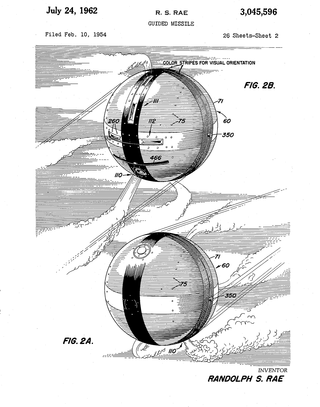
The Cannonball Missile also known as the D-40 was designed by the Applied Physics Laboratory of the Johns Hopkins University under a United States Navy contract in the early 1950s. The missile originally started out as an anti-ship missile to be launched from submarines. In 1952 the US Army Chief of Ordnance funded the project for development as an anti-tank missile. Between 1953 and 1956, around 50 D-40 missiles were test fired.

HJ-10 is a Chinese ground-launched anti-tank missile developed by Norinco. It has a tandem high-explosive anti-tank (HEAT) warhead, that may penetrate 1,400 mm (55 in) of conventional steel armour protected by explosive reactive armour. The maximum range is 10 km (6.2 mi), with pre- or post-launch lock-on.
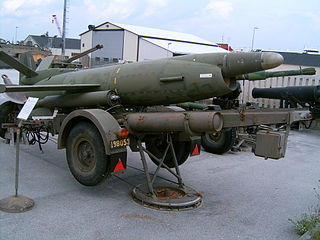
Robot 08 was a Swedish anti-ship missile. It was the first operational ship-based anti-ship missiles. The design was a development of the French Nord Aviation CT20 target missile and was manufactured by Saab. The project to develop the weapon was initiated in the 1950s and the missile entered service in 1966 aboard the Halland-class destroyers, later also serving with the Swedish Coastal Artillery. Guidance was via radio command and active radar homing. The missile was replaced by the RBS-15, being retired in 1995.

The Kestrel is an individual shoulder-launched weapon system developed by Taiwan's National Chung-Shan Institute of Science and Technology and currently in service with the Republic of China Armed Forces and Coast Guard Administration.

